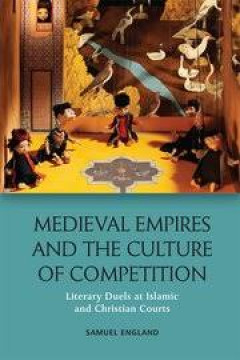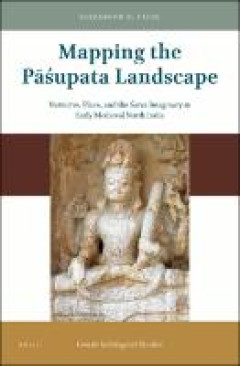Ditapis dengan

Medieval empires and the culture of competition:literary duels at Islamic and…
Shows how the interactive, confrontational practice of courtly arts shaped imperial thought in the Middle AgesA probing inquiry into medieval court struggles, this book shows the relationship between intellectual conflict and the geopolitics of empire. It examines the Persian Buyids’ takeover of the great Arab caliphate in Iraq, the counter-Crusade under Saladin, and the literature of soverei…
- Edisi
- -
- ISBN/ISSN
- 9781474425223
- Deskripsi Fisik
- viii, 230 pages ; 25 cm
- Judul Seri
- -
- No. Panggil
- 909.07 ENG m

Modes of philology in medieval South India
In Modes of Philology in Medieval South India, Whitney Cox rethinks the textual practices of a diverse collection of scholars and poets writing in Sanskrit, Tamil, and Prakrit in far southern India between the 11th and the 14th centuries CE.
- Edisi
- -
- ISBN/ISSN
- 9789004331679
- Deskripsi Fisik
- 208 p.; 22 cm.
- Judul Seri
- -
- No. Panggil
- 100 COX m

Mythodologies:Methods in Medieval Studies, Chaucer, and Book History
Mythodologies challenges the implied methodology in contemporary studies in the humanities. We claim, at times, that we gather facts or what we will call evidence, and from that form hypotheses and conclusions. Of course, we recognize that the sum total of evidence for any argument is beyond comprehension; therefore, we construct, and we claim, preliminary hypotheses, perhaps to organize the ch…
- Edisi
- -
- ISBN/ISSN
- 9781947447578
- Deskripsi Fisik
- 292 p.
- Judul Seri
- -
- No. Panggil
- 001.30721 DAN m

Mapping the pāśupata landscape :narrative, place, and the saiva imaginary i…
In Mapping the Pāśupata Landscape Elizabeth A. Cecil presents a spatial and material history of the Pāśupata tradition and examines the formation of a Śaiva religious landscape in Early Medieval India. Readership: All interested in the history of Hinduism, and particularly the worship of the god Śiva, in premodern India; scholars of early medieval history and society in South Asia, and th…
- Edisi
- -
- ISBN/ISSN
- 9789004424425
- Deskripsi Fisik
- XIII, 271 p.
- Judul Seri
- -
- No. Panggil
- 704.948945 CEC m

The archaeology of death in post-medieval Europe
Historical burial grounds are an enormous archaeological resource and have the potential to inform studies not only of demography or the history of disease and mortality, but also histories of the body, of religious and other beliefs about death, of changing social relationships, values and aspirations.In the last decades, the intensive urban development and a widespread legal requirement to un…
- Edisi
- -
- ISBN/ISSN
- 9783110439731
- Deskripsi Fisik
- V, 227 p.
- Judul Seri
- -
- No. Panggil
- 393.094 TAR a

Material aspects of reading in ancient and medieval cultures :materiality, pr…
This publication seeks to endeavour the relationship between material artefacts and reading practices in ancient and medieval cultures. While the acts of reception of written artefacts in former times are irretrievably lost, some of the involved artefacts are preserved and might comprise hints to the ancient reading practices. In form of case studies, the contributions to this volume examine …
- Edisi
- -
- ISBN/ISSN
- 9783110639247
- Deskripsi Fisik
- VIII, 266 p.
- Judul Seri
- -
- No. Panggil
- 306 MAT m

Living with disfigurement in early medieval Europe
This book examines social and medical responses to the disfigured face in early medieval Europe, arguing that the study of head and facial injuries can offer a new contribution to the history of early medieval medicine and culture, as well as exploring the language of violence and social interactions. Despite the prevalence of warfare and conflict in early medieval society, and a veritable indu…
- Edisi
- -
- ISBN/ISSN
- 9781137544391
- Deskripsi Fisik
- x, 282p. : ill.
- Judul Seri
- -
- No. Panggil
- 809.02 SKI l

Excavations at Paithan, Maharashtra :transformations in early historic and ea…
This book reports on excavations at Paithan in India revealed the development of two early Hindu temples from the 4th century to the 9th: the key formative phase of Hinduism. The temples started as small shrines but were elaborated into formal temples. In relation to these changes, the excavations revealed a sequence of palaeobotanical and palaeofaunal evidence that give insight into the econom…
- Edisi
- -
- ISBN/ISSN
- 9783110653540
- Deskripsi Fisik
- XX, 386 p.
- Judul Seri
- -
- No. Panggil
- 956.94 KER e

Pandemic disease in the medieval world:rethinking the Black Death
This ground-breaking book brings together scholars from the humanities and social and physical sciences to address the question of how recent work in the genetics, zoology, and epidemiology of plague's causative organism (Yersinia pestis) can allow a rethinking of the Black Death pandemic and its larger historical significance.
- Edisi
- -
- ISBN/ISSN
- 9781942401018
- Deskripsi Fisik
- xx, 339 pages : illustrations (some color) ; 25 cm.
- Judul Seri
- -
- No. Panggil
- 614.4 PAN p

Authority and authorship in medieval and seventeenth century women's visionar…
In medieval and early modern times, female visionary writers used the mode of prophecy to voice their concerns and ideas, against the backdrop of cultural restrictions and negative stereotypes. In this book, Deborah Frick analyses medieval visionary writings by Julian of Norwich and Margery Kempe in comparison to seventeenth-century visionary writings by authors such as Anna Trapnel, Mary Cary,…
- Edisi
- -
- ISBN/ISSN
- 9783839456897
- Deskripsi Fisik
- 153 p.
- Judul Seri
- -
- No. Panggil
- 421 FRI a

Medieval disability sourcebook :Western Europe
The field of disability studies significantly contributes to contemporary discussions of the marginalization of and social justice for individuals with disabilities. However, what of disability in the past? The Medieval Disability Sourcebook: Western Europe explores what medieval texts have to say about disability, both in their own time and for the present. This interdisciplinary volume on med…
- Edisi
- -
- ISBN/ISSN
- 9781950192748
- Deskripsi Fisik
- 495 p. : ill.
- Judul Seri
- -
- No. Panggil
- 305 MCN m

The juggler of Notre Dame and the medievalizing of modernity :volume 6 war an…
This ambitious and vivid study in six volumes explores the journey of a single, electrifying story, from its first incarnation in a medieval French poem through its prolific rebirth in the nineteenth and twentieth centuries. The Juggler of Notre Dame tells how an entertainer abandons the world to join a monastery, but is suspected of blasphemy after dancing his devotion before a statue of the M…
- Edisi
- -
- ISBN/ISSN
- 9781783745418
- Deskripsi Fisik
- 324 p. : ill. ; 25.4 cm.
- Judul Seri
- -
- No. Panggil
- 841.109 ZIO t

The juggler of Notre Dame and the medievalizing of modernity :volume 5 tumbli…
This ambitious and vivid study in six volumes explores the journey of a single, electrifying story, from its first incarnation in a medieval French poem through its prolific rebirth in the nineteenth and twentieth centuries. The Juggler of Notre Dame tells how an entertainer abandons the world to join a monastery, but is suspected of blasphemy after dancing his devotion before a statue of the M…
- Edisi
- -
- ISBN/ISSN
- 9781783745364
- Deskripsi Fisik
- 397 p. : ill. ; 25.4 cm.
- Judul Seri
- -
- No. Panggil
- 841.109 ZIO t

The juggler of Notre Dame and the medievalizing of modernity :volume 3 The Am…
This ambitious and vivid study in six volumes explores the journey of a single, electrifying story, from its first incarnation in a medieval French poem through its prolific rebirth in the nineteenth and twentieth centuries. The Juggler of Notre Dame tells how an entertainer abandons the world to join a monastery, but is suspected of blasphemy after dancing his devotion before a statue of the M…
- Edisi
- -
- ISBN/ISSN
- 9781783745234
- Deskripsi Fisik
- 482 p. : ill. ; 25.4 cm.
- Judul Seri
- -
- No. Panggil
- 841.109 ZIO t

The juggler of Notre Dame and the medievalizing of modernity :volume 1 the mi…
This ambitious and vivid study in six volumes explores the journey of a single, electrifying story, from its first incarnation in a medieval French poem through its prolific rebirth in the nineteenth and twentieth centuries. The Juggler of Notre Dame tells how an entertainer abandons the world to join a monastery, but is suspected of blasphemy after dancing his devotion before a statue of the M…
- Edisi
- -
- ISBN/ISSN
- 9781783744350
- Deskripsi Fisik
- 395 p. : ill. ; 25.4 cm.
- Judul Seri
- -
- No. Panggil
- 841.109 ZIO t

The juggler of Notre Dame and the medievalizing of modernity :volume 4 pictur…
This ambitious and vivid study in six volumes explores the journey of a single, electrifying story, from its first incarnation in a medieval French poem through its prolific rebirth in the nineteenth and twentieth centuries. The Juggler of Notre Dame tells how an entertainer abandons the world to join a monastery, but is suspected of blasphemy after dancing his devotion before a statue of the M…
- Edisi
- -
- ISBN/ISSN
- 9781783745319
- Deskripsi Fisik
- 510 p. : ill. ; 25.4 cm.
- Judul Seri
- -
- No. Panggil
- 841.109 ZIO t

Two studies on Ming history
In the first study of Two Studies on Ming History , Charles O. Hucker presents an account of a military campaign that provides insight into the nature of civil officials' authority, decision-making, and relationship with the Ming court. In the spring and summer of 1556, a Chinese renegade named Hsü Hai led an invading group of Japanese and Chinese soldiers on a plundering foray through the nor…
- Edisi
- -
- ISBN/ISSN
- 9780472127573
- Deskripsi Fisik
- 93 p. ; ill
- Judul Seri
- -
- No. Panggil
- 951.026 HUC t

Morphosyntactic variation in medieval Celtic languages :corpus-based approaches
This book showcases the state of the art in corpus-based linguistic analysis of Celtic languages (specifically, Old/Middle Irish, Middle Welsh, and Cornish). It explores corpus approaches to morphosyntactic variation in the medieval Celtic languages and, for the first time, situates them in the broader field of computational and corpus linguistics by providing descriptions of tools for processi…
- Edisi
- -
- ISBN/ISSN
- 9783110680744
- Deskripsi Fisik
- xviii, 396 p. : ill.
- Judul Seri
- -
- No. Panggil
- 491.627 LAS m

Medieval Hackers
Medieval Hackers calls attention to the use of certain vocabulary terms in the Middle Ages and today: commonness, openness, and freedom. Today we associate this language with computer hackers, some of whom believe that information, from literature to the code that makes up computer programs, should be much more accessible to the general public than it is. In the medieval past these same terms w…
- Edisi
- -
- ISBN/ISSN
- 9780692352465
- Deskripsi Fisik
- ScholarLed
- Judul Seri
- -
- No. Panggil
- -

Beards and texts :images of masculinity in medieval German literature
Beards and Texts explores the literary portrayal of beards in medieval German texts from the mid-twelfth to the early sixteenth centuries. It argues that as the pre-eminent symbol for masculinity the beard played a distinctive role throughout the Middle Ages in literary discussions of such major themes as majesty and humanity. At the same time beards served as an important point of reference in…
- Edisi
- -
- ISBN/ISSN
- 9781787352216
- Deskripsi Fisik
- xi, 220p. ill;
- Judul Seri
- -
- No. Panggil
- 830.935211 BEA S
 Karya Umum
Karya Umum  Filsafat
Filsafat  Agama
Agama  Ilmu-ilmu Sosial
Ilmu-ilmu Sosial  Bahasa
Bahasa  Ilmu-ilmu Murni
Ilmu-ilmu Murni  Ilmu-ilmu Terapan
Ilmu-ilmu Terapan  Kesenian, Hiburan, dan Olahraga
Kesenian, Hiburan, dan Olahraga  Kesusastraan
Kesusastraan  Geografi dan Sejarah
Geografi dan Sejarah